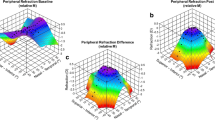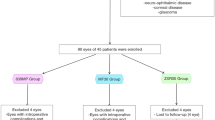Abstract
Purpose
To evaluate the visual outcomes, visual performance, and stereoacuity in presbyopic patients following treatment by a change in the corneal asphericity and micro-monovision.
Methods
Presbyopic patients with diverse refractive errors and emmetropes (n = 30 eyes) were treated with a custom Q-ablation profile and micro-monovision in the non-dominant eye. There with a difference of Q − 0.30 in the Q profiles between dominant and non-dominant eyes. Patients were assigned in two groups based on the preoperative spherical equivalent (Group 1 + 4.00 to + 0.50, and group 2 neutral to − 3.00). Binocular uncorrected distance visual acuity (binocular UCVA), best-corrected visual acuity (BCVA), binocular uncorrected near visual acuity (binocular UNVA) preoperative and postoperative, spherical equivalent refraction, contrast sensitivity, and stereopsis were analyzed at 1, 3, and 6 months.
Results
The mean age was 52.6 ± 5.1 (SD) years. At six months post-operation, the mean binocular uncorrected distance visual acuity (binocular UDVA) was 0.15 ± 0.04 logMAR (20/25-) in group 1, and 0.11 ± 0.05 logMAR (20/25) in group 2, and binocular uncorrected near vision UNVA was 0.5 ± 0.1 M (20/25 J2) in group 1 and 0.45 ± 0.2 M (20/25 J2) group 2. An increase in stereoacuity was found in both groups.
Conclusions
The correction of refractive defects using customized corneal asphericity was an effective treatment in presbyopic patients. Furthermore, the treatment was well tolerated in this group of patients. Following surgery, the quality of vision was adequate, and the stereovision improved in this cohort of patients.





Similar content being viewed by others
Data availability
The data that support the findings of this study are available on request from the corresponding author (MYA). The data are not publicly available due to (containing information that could compromise research participant privacy/consent”).
References
Holden BA, Fricke TR, Ho SM, Wong R, Schlenther G, Cronjé S, Burnett A, Papas E, Naidoo KS, Frick KD (2008) Global vision impairment due to uncorrected presbyopia. Arch Ophthalmol 126(12):1731–1739
Evans BJ (2007) Monovision: a review. Ophthalmic Physiol Opt 27(5):417–439
Alió JL, Chaubard JJ, Calíz A, Sala E, Patel S (2006) Correction of presbyopia by technovision central multifocal LASIK (presbyLASIK). J Refract Surg 22(5):453–460
El Danasoury AM, Gamaly TO, Hantera M (2009) Multizone LASIK with peripheral near zone for correction of presbyopia in myopic and hyperopic eyes: 1-year results. J Refract Surg 25(3):296–305
Wright KW, Guemes A, Kapadia MS, Wilson SE (1999) Binocular function and patient satisfaction after monovision induced by myopic photorefractive keratectomy. J Cataract Refract Surg 25(2):177–182
Fawcett SL, Herman WK, Castleberry KA, Parks MM (2002) LASIK monovision for presbyopia results in an uncorrectable loss of foveal binocular vision. Investig Ophthalmol Vis Sci 43(13):2943
Wang Yin GH, McAlinden C, Pieri E, Giulardi C, Holweck G, Hoffart L (2016) Surgical treatment of presbyopia with central presbyopic keratomileusis: one-year results. J Cataract Refract Surg 42(10):1415–1423
Reinstein DZ, Carp GI, Archer TJ, Gobbe M (2012) LASIK for presbyopia correction in emmetropic patients using aspheric ablation profiles and a micro-monovision protocol with the Carl Zeiss Meditec MEL 80 and VisuMax. J Refract Surg 28(8):531–541
Romero M, Castillo A, Carmona D, Palomino C (2019) Visual quality after presbyopia correction with excimer laser ablation using micromonovision and modulation of spherical aberration. J Cataract Refract Surg 45(4):457–464
Alarcón A, Anera RG, Villa C, Jiménez del Barco L, Gutierrez R (2011) Visual quality after monovision correction by laser in situ keratomileusis in presbyopic patients. J Cataract Refract Surg 37(9):1629–1635
Alarcón A, Anera RG, Soler M, Del Barco LJ (2011) Visual evaluation of different multifocal corneal models for the correction of presbyopia by laser ablation. J Refract Surg 27(11):833–836
Kasthurirangan S, Glasser A (2006) Age related changes in the characteristics of the near pupil response. Vis Res 46(8–9):1393–1403
Kasthurirangan S, Glasser A (2005) Influence of amplitude and starting point on accommodative dynamics in humans. Investig Ophthalmol Vis Sci 46(9):3463–3472
Heron G, Charman WN, Schor CM (2001) Age changes in the interactions between the accommodation and vergence systems. Optom Vis Sci 78(10):754–762
Jafarinasab MR, Feizi S, Baghi AR, Ziaie H, Yaseri M (2010) Aspheric versus Spherical Posterior Chamber Intraocular Lenses. J Ophthalmic Vis Res 5(4):217–222
Funding
This study was not founded by any external Grant.
Author information
Authors and Affiliations
Contributions
The study was designed and directed by MYA, as Principal investigator as well as the surgeries, P R performed the evaluation of patients and statistical analysis. The manuscript was written by MYA and PR and was commented, and revised by MYA and PR.
Corresponding author
Ethics declarations
Conflicts of interest
Author Marcel Y Avila, and Paola Reyes declare that have no conflict of interest in any of the products or equipment cited in this work.
Ethical approval
All procedures performed in studies involving human participants were in accordance with the ethical standards of the institutional IRB from Facultad de Medicina Universidad Nacional del Colombia under the approval letter 006-066-19 (attached as a PDF) with the 1964 Helsinki declaration and its later amendments or comparable ethical standards.
Informed consent
Informed consent was obtained from all individual participants included in the study and is included in the IRB 006-066-19.
Consent to participate
Consent to participate was obtained from all individual participants included in the study and is included in the IRB 006-066-19.
Consent for publication
Consent to participate was obtained from all individual participants included in the study and is included in the IRB 006-066-19.
Additional information
Publisher's Note
Springer Nature remains neutral with regard to jurisdictional claims in published maps and institutional affiliations.
Rights and permissions
About this article
Cite this article
Avila, M.Y., Vivas, P.R. Visual outcomes in hyperopic myopic and emmetropic patients with customized aspheric ablation (Q factor) and micro-monovision. Int Ophthalmol 41, 2179–2185 (2021). https://doi.org/10.1007/s10792-021-01775-4
Received:
Accepted:
Published:
Issue Date:
DOI: https://doi.org/10.1007/s10792-021-01775-4




